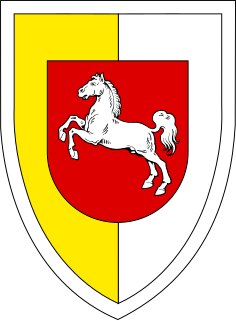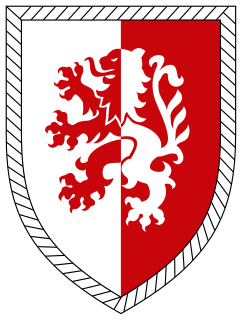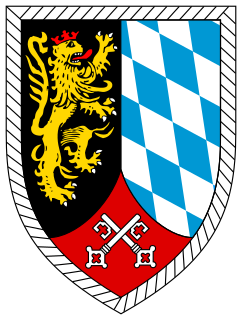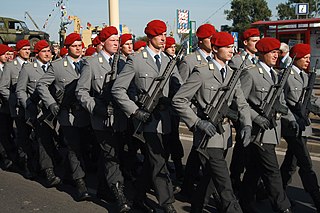
The German Army is the land component of the armed forces of Germany. The present-day German Army was founded in 1955 as part of the newly formed West German Bundeswehr together with the Marine and the Luftwaffe. As of April 2020, the German Army had a strength of 64,036 soldiers.

The 10th Panzer Division was an armoured division in the German Army, the Heer, during World War II, established in March 1939.

The 1st Panzer Division(German: "1. Panzerdivision", short: "1. PzDiv") is an armoured division of the German Army. Its headquarter is based in Oldenburg. In the course of the last reorganisation of the Bundeswehr it became the backbone of Germany's newly formed intervention forces with a manpower of 35,000 soldiers. The division is equipped and trained for high intensity combat operations against militarily organized enemies as well as peacekeeping missions. The majority of all German troops assigned to EU-Battlegroups and Nato Response Forces will come from this division. It also represents Germany's permanent contribution to the binational I. German/Dutch Corps.
The 10th Panzer Division is an armoured division of the German Army, part of the Bundeswehr. Its staff is based at Veitshöchheim. The division is a unit of the German Army's stabilization forces and specializes in conflicts of low intensity.
The 13th Panzergrenadier Division was a mechanized division of the German Army. Its staff was based at Leipzig. The division was a unit of the German Army's stabilization forces and specialized on conflicts of low intensity and homeland defense. The division was Germany's permanent contribution to Multinational Corps North East.

The Northern Army Group (NORTHAG) was a NATO military formation comprising four Western European Army Corps, during the Cold War as part of NATO's forward defence in the Federal Republic of Germany.

The 9th Panzerlehr Brigade is a formation of about 5,000 men strong within the German Armed Forces or Bundeswehr, which is subordinated to the 1st Panzer Division in Hanover. The bulk of the brigade is stationed in Munster. Two battalions are based in Neustadt am Rübenberge. The brigade has become the "showcase of the German Army" as a result of its German Army Combat Vehicle and Aircraft Demonstration Exercises which it has conducted for decades. These exercises demonstrate the capability of the Army's fighting vehicles and aircraft and how they operate jointly in various scenarios. The formation is classified as an armoured brigade within the Bundeswehr's intervention forces.
The Army Forces Command in Falckenstein Barracks in Koblenz was one of the two leadership pillars of the German Army, together with the German Army Office, before it was merged into the Army Command.

The 5th Armoured Division was a West German armored formation. It was part of the III Corps of the Bundeswehr, which also incorporated in 1985 the 2nd Panzergrenadier Division and 12th Panzer Division. III Corps was part of NATO's Central Army Group (CENTAG), along with the Bundeswehr's II Corps and the American V and VII Corps. Headquarters in 1985 was at Diez/Lahn, with subordinate brigades at Wetzlar, Neustadt/Marburg and Koblenz.

Günter Friedrich Weiler is a retired Lieutenant General of the German Army, the Bundeswehr. From 16 September 2010 until 9 April 2013, he was the Deputy Inspector General of the Bundeswehr.

III Corps was a corps of the German Army active from 1957 to 1994.

The 3rd Armoured Division was formed on 2 July 1956 in Hamburg and was one of the first major formations of the new German Army or Bundeswehr after the Second World War. The 3rd Armoured Division was stationed on the North German Plain between the rivers Elbe and Weser. Its last headquarters location was Buxtehude. It was part of the I Corps alongside the 1st Panzer, 7th Panzer, and 11th Panzergrenadier Divisions.

The 2nd Panzergrenadier Division was a West German mechanized infantry formation. It was part of the III Corps of the Bundeswehr, which also incorporated in 1985 the 5th Panzer Division and 12th Panzer Division. III Corps was part of NATO's Central Army Group (CENTAG), along with the Bundeswehr's II Corps and the American V and VII Corps. In the wake of military restructuring brought about by the end of the Cold War, the 2nd Panzergrenadier Division was disbanded in 1994.

The 4th Panzergrenadier Division was a West German mechanized infantry formation. It was part of the II Corps of the Bundeswehr, which also incorporated in 1979 the 1st Mountain Division and 1st Airborne Division, and the 10th Panzer Division. II Corps was part of NATO's Central Army Group (CENTAG), along with the Bundeswehr's III Corps and the American V and VII Corps. In the wake of military restructuring brought about by the end of the Cold War, the 4th Panzergrenadier Division was disbanded in 1994 with some of its forces being used to form the Airmobile Forces Command /4th Division.
The 11th Panzergrenadier Division was a West German mechanized infantry formation. It was part of the I Corps of the Bundeswehr. I Corps was part of NATO's Northern Army Group (NORTHAG), along with the I Belgian Corps, I British Corps, and the I Netherlands Corps. In the wake of military restructuring brought about by the end of the Cold War, the 11th Panzergrenadier Division was disbanded in 1994.
The 6th Panzergrenadier Division was a West German mechanized infantry formation. It was part of the I Corps of the Bundeswehr during peacetime, but fell under Allied Land Forces Schleswig-Holstein and Jutland Command in case of war. In the wake of military restructuring brought about by the end of the Cold War, the 6th Panzergrenadier Division was disbanded in 1994, although a military readiness command incorporated the division's name until 1997.
The 14th Panzergrenadier Division was a German mechanized infantry formation. It was part of the Multinational Corps Northeast, a NATO corps that includes German, Polish, and Danish troops. In the wake of military restructuring aimed at reducing the size of the German land forces, the 14th Panzergrenadier Division was disbanded in 2008. The division's formation was notable in that it was a Bundeswehr formation created after the reunification of the Federal Republic of Germany and the German Democratic Republic, and which was formed in part from soldiers who had served in the National People's Army (NVA) of the GDR.

The 1st Mountain Division was a West German mountain infantry formation. It was part of the II Corps of the Bundeswehr. In the wake of military restructuring brought about by the end of the Cold War, the 1st Mountain Division was disbanded in 2001.
The following lists German active and reserve units within the structure of the German Army . Reserve units do not possess any heavy equipment and their personnel is intended as replacements for losses sustained by regular units.

The Fernmeldetruppe is the Military communications arm of service in the German Army and in the Joint Support Service of the Bundeswehr. The Fernmeldetruppe is one of the Combat Support arms. The Army Telecommunications Force is responsible for the operation of the Army's communications and information network.














